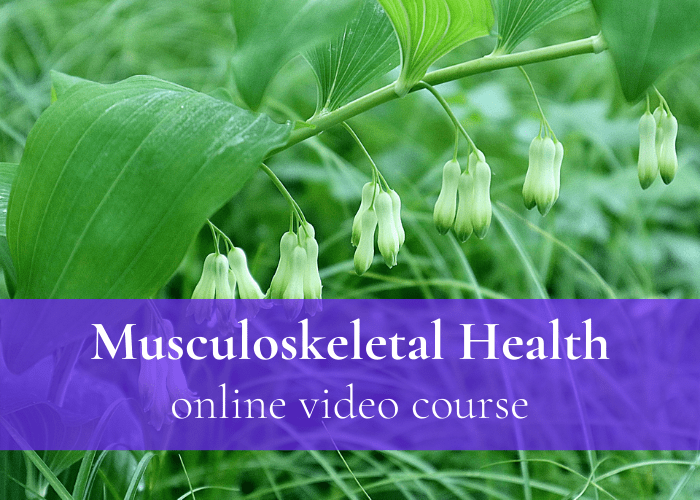Kelp: Herb of the Week
Not all herbs live on the land! This week we’re featuring kelp, bladderwrack, and all the brown seaweeds.
Minerals in Kelp
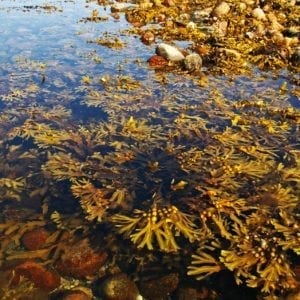
Seaweeds are superfoods, if anything is. All seaweeds used as food or medicine are extremely mineral-rich, often carrying a complement of minerals and trace elements not found easily in land plants. Seaweeds are renowned for their iodine content, but that’s not the only mineral they carry in abundance: magnesium, calcium, potassium, iron, iodine, chromium, and many more make their appearance. The ocean has been described as “a very dilute solution of everything”, so this should not surprise us!
A building, nutritive plant, adding kelp to the diet in the form of soups, homemade seaweed chips, and homemade seaweed salads helps to support cardiac and thyroid function, flexibility throughout the body, and a healthy supply of moisture to the tissues.
Kelp is an excellent food, regardless of the state of someone’s health. On the medicinal level, it’s worth knowing that wound-healing, cardiac tonic, musculoskeletal tonic, and thyroid trophorestorative actions can often be attributed to “mere” mineral intake and assimilation. Your elemental Earth is no joke, folks! Even when it comes out of the sea.
Iodine in Kelp
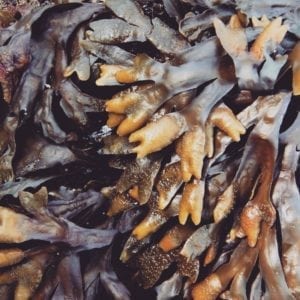
An excellent source of dietary iodine, kelp nourishes the thyroid and helps to restore normal function in instances of hypothyroidism, though it also can be useful in some cases of hyperthyroidism. Iodine matters so much for thyroid health because its hormones require iodine for their construction. Diets deficient in iodine are simply lacking in the raw materials for thyroid hormone production.
Thyroid troubles don’t stay local, they effect other organs too. The heart, adrenals, bones, and blood are all directly affected by fluctuations in thyroid activity. One reason is the influence the thyroid has on various blood parameters – when thyroid function is disordered, electrolyte and cholesterol levels get out of balance, among others.
This study of blood mineral levels of thyroid disorder sufferers outlines some of the known trends – here, I exploded some acronyms for you:
“The [overt hypothyroid] group showed impaired renal function; whereas, the kidney function of the [subclinical hyper, overt hyper, and thyroxine-treated] groups was normal. The [overt hypo] and [overt hyper] groups exhibited elevated serum glucose. The [overt hypo] group showed elevated serum cholesterol, triglyceride, and low-density lipoprotein cholesterol, and decreased high-density lipoprotein cholesterol. Serum lipids were reduced in the [overt hyper] group, and no different in the [thyroxine-treated] group compared with controls. The serum calcium and phosphate were reduced in the [overt hypo] group, whereas, in the [overt hyper] group, the phosphate was increased while magnesium and potassium were reduced.”
Iodine also helps some types of breast pain, PMS, and is of use in certain cancers. This is because imbalanced alterations in fluid movement and inflammatory reactions can produce these kinds of consequences if unchecked. Such imbalances can arise when iodine is insufficient; restoring it corrects the imbalance.
So to expand on its role as a cardiac tonic, we can say that kelp’s mineral content helps to improve nutrition to the cardiac tissue, both simply by being present and bioavailable (as with calcium, magnesium, etc), as well as with the iodine in particular, by improving thyroid-mediated regulation of blood parameters. Meanwhile, its moisture content deeply rehydrates, which improves the flexibility and tone of the cardiac muscle.
B Vitamins in Kelp
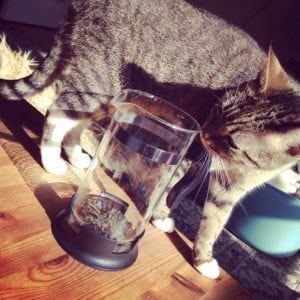
So! Kelp contains a great many essential minerals, trace elements, and vitamins, including some of the B vitamins – it’s a decent source of B2, B6, & B9 (aka folate).
It is not, however, a good source of vitamin B12.
You may have heard otherwise! Here’s what’s up:
Macroalgae (seaweeds) contain a lot of “pseudovitamin B12”, various non-functional cobamides. They’re not B12, but they’re -almost- B12. Almost. Their shapes are similar enough that they can trick a lot of tests, but where it counts – for neurological, immune, and metabolic health – they can’t do what your body needs. For that you need a true B12, either cyanocobalamin or, better, methylcobalamin.
So, seaweeds only have this problem-causing pseudo-B12. (Or, to be more specific, they have -more- pseudo than true B12. In spirulina it’s 83% pseudo : 17% true, and that’s a microalgae famed for its B12 content; macroalgae like seaweeds have even lower ratios. And that’s happening within 1/15th to 1/30th the total cobamide content, to boot!)
But, beware: some blood tests of B12 status will be unable to differentiate between true & pseudo B12, so your score could get artificially inflated and, if you relied solely on that test, you’d end up with “mysterious” symptoms of B12 deficiency while believing you’re replete. No good!
Fortunately, if you eat healthy animal foods, it’s usually easy to get enough B12. For vegans, supplementation is necessary; you can get one in which the B12 is produced by tricking bacteria into making it.
Watery Ways
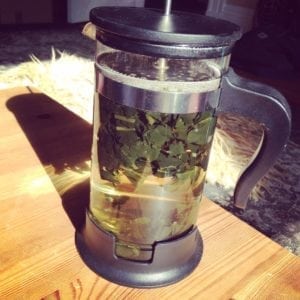
We can evaluate the energetic qualities of our sea herbs just as we do land plants. But to give the game away a little bit, seaweeds are universally cooling, moistening, & relaxant. Their salty & sweet tastes speak to this – remember, water follows salt.
As an herbal medicine, kelp is particularly appropriate for dry and deficient individuals who are experiencing a depression of function, or inflexibility of the tissues, due to undernourishment and dehydration. Its demulcent quality serves to hydrate and lubricate tissues so you can stay fluid.
The mannitol, alginates, laminaran and related compounds in kelp present us with what the herbalist jim mcdonald aptly calls “slimaceous” qualities – somewhat like the mucilage and polysaccharides of the mallows and elms. But that’s not all: they’re -also- somewhat like certain immunomodulating/anticancer polysaccharides such as the beta-glucans from medicinal mushrooms. Pretty amazing stuff, and completely unique to water plants.
To acquire these aspects of kelp’s medicine, you’ll want to take it internally – in soup, as decoction, or in a nice long infusion.
These nutritive and moistening actions of kelp apply to all of the skeletal muscles as well, improving the structural integrity and flexibility of the muscles, tendons, and joints. Bladderwrack is particularly good at slowing down joint deterioration – resilient elders of the future, take note!
Kelp is helpful for these musculoskeletal aspects both when taken internally, and when applied externally to muscle strains, sprains, and tears.
Kelp Wraps & Topical Applications

Kelp is perfect for topical applications. The long “leaves” – lamina, roughly equivalent to “aerial parts” if comparing to land plants – are very easy to work with once they’ve been rehydrated. They can be wrapped around limbs or even the whole body, or you can take a nice seaweed soak. You don’t have to visit a fancy spa for an expensive seaweed “treatment,” you can do it at home! A DIY spa day – that’s herbalism too.
An emollient, kelp applied topically will hydrate the skin, improving its tone and quality, while also softening scar tissue and loosening adhesions in the superficial fascia. Brown seaweeds like kelp are particularly good at promoting the formation of fibronectin, which keeps joints lubricated and flexible.
Kelp is even somewhat disinfectant, so you can feel confident applying it to wounds to accelerate healing time. It promotes skin healing, and is particularly good at healing burns.
PS: Seaweed names are frequently mixed up, “kelp” especially. The generic term “kelp” could refer to anything in the order Laminariales. In addition to Alaria esculenta, kelp is sometimes used to refer to Laminaria longicruris, which is relatively similar. Parboiled Alaria is frequently called wakame. The Alariaceae family is a member of the Laminariales, along with the Laminariaceae and others. (You followed all that, right?) These are all BROWN seaweeds. So, when we refer to “kelp”, it’s fair to say we’re referring to brown seaweeds – if we remember an exception we’ll let you know, or please, tell us if you think of one! Other brown seaweeds include kombu (Laminaria japonica/digitata) and bladderwrack (Fucus vesiculosus). We’ll feature the red seaweeds next week.
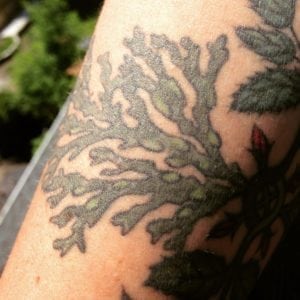
PPS: One reason we chose kelp for this week is that our anniversary’s coming up, and we checked to see if we’d covered all our tattoo herbs yet. But we hadn’t! Katja’s water herb in her wedding tattoo is bladderwrack. (Who were your wedding herbs?)
Kelp is one of our favorite herbs for supporting muscles, joints, and connective tissues – but it’s not the only one! Learn about all our best herbs to relieve joint pain, improve workout recovery times, align the spine, and much more in our Musculoskeletal Health course. As with all our online video courses, you get lifetime access to the material – plus any future updates we add later! And you also get invited to our live, twice-weekly Q&A sessions with Katja & Ryn. Check it out and start building healthier bones & stronger muscles today!
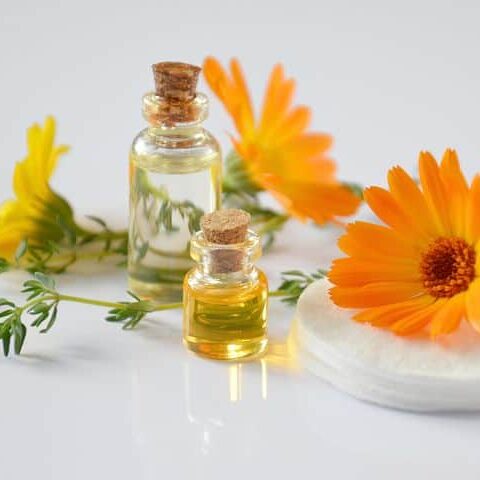
Join our newsletter for more herby goodness!
Get our newsletter delivered right to your inbox. You'll be first to hear about free mini-courses, podcast episodes, and other goodies about holistic herbalism.

